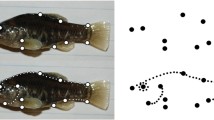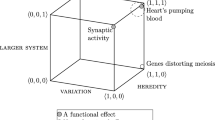Abstract
We describe an emerging framework for understanding variation, selection and evolution of phenotypic traits that are mathematical functions. We use one specific empirical example – thermal performance curves (TPCs) for growth rates of caterpillars – to demonstrate how models for function-valued traits are natural extensions of more familiar, multivariate models for correlated, quantitative traits. We emphasize three main points. First, because function-valued traits are continuous functions, there are important constraints on their patterns of variation that are not captured by multivariate models. Phenotypic and genetic variation in function-valued traits can be quantified in terms of variance-covariance functions and their associated eigenfunctions: we illustrate how these are estimated as well as their biological interpretations for TPCs. Second, selection on a function-valued trait is itself a function, defined in terms of selection gradient functions. For TPCs, the selection gradient describes how the relationship between an organism's performance and its fitness varies as a function of its temperature. We show how the form of the selection gradient function for TPCs relates to the frequency distribution of environmental states (caterpillar temperatures) during selection. Third, we can predict evolutionary responses of function-valued traits in terms of the genetic variance-covariance and the selection gradient functions. We illustrate how non-linear evolutionary responses of TPCs may occur even when the mean phenotype and the selection gradient are themselves linear functions of temperature. Finally, we discuss some of the methodological and empirical challenges for future studies of the evolution of function-valued traits.
Similar content being viewed by others
References
Arnold, S.J. & M.J. Wade, 1984a. On the measurement of natural and sexual selection: applications. Evolution 38: 720–734.
Arnold, S.J. & M.J. Wade, 1984b. On the measurement of natural and sexual selection: theory. Evolution 38: 709–719.
Beder, J.H. & R. Gomulkiewicz, 1998. Computing the selection gradient and evolutionary response of an infinite-dimensional trait. J. Math. Biol. 36: 299–319.
Benrey, B. & R.F. Denno, 1997. The slow-growth-high-mortality hypothesis: a test using the cabbage butterfly. Ecology 78: 987–999.
Casey, T.M., 1993. Effects of temperature on foraging of caterpillars, pp. 5–28 in Caterpillars: Ecological and Evolutionary Constraints on Foraging, edited by N.E. Stamp and T.M. Casey. Chapman & Hall, New York.
Cowley, D.E. & W.R. Atchley, 1990. Development and quantitative genetics of correlation structure among body parts of Drosophila melanogaster. Am. Nat. 135: 242–268.
DeJong, G., 1990. Genotype-by-environment interaction and the genetic covariance between environments: multilocus genetics. Genetica 81: 171–177.
Endler, J.A., 1986. Natural selection in the wild. Princeton University Press, Princeton, NJ.
Falconer, D.S. & T.F.C. MacKay, 1996. Introduction to quantitative genetics. Longman, Essex.
Gibert, P., B. Moreteau, J.R. David & S.M. Scheiner, 1998. Describing the evolution of reaction norm shape: body pigmentation in Drosophila. Evolution 52: 1501–1506.
Gilchrist, G.W., 1996. A quantitative genetic analysis of thermal sensitivity in the locomotor performance curve of Aphidius ervi. Evolution 50: 1560–1572.
Gomulkiewicz, R., 1998. Game theory, optimization, and quantitative genetics, pp. 283–303 in Game theory and Animal Behavior, edited by L.A. Dugatkin and H.K. Reeve. Oxford University Press, Oxford, UK.
Gomulkiewicz, R. & M. Kirkpatrick, 1992. Quantitative genetics and the evolution of reaction norms. Evolution 46: 390–411.
Grant, B.R., 1985. Selection on bill characters in a population of Darwin' finches: Geospiza conirostris on Isla Genovesa, Galapagos. Evolution 39: 523–532.
Hertz, P.E., R.B. Huey & T. Garland, Jr, 1988. Time budgets, thermoregulation, and maximal locomotor performance: are reptiles Olympians or Boy Scouts? Am. Zoolog. 28: 927–938.
Huey, R.B. & J.G. Kingsolver, 1989. Evolution of thermal sensitivity of ectotherm performance. Trends Ecol. Evol. 4: 131–135.
Huey, R.B. & R.D. Stevenson, 1979. Integrating thermal physiology and ecology of ectotherms: a discussion of approaches. Am. Zoolog. 19: 357–366.
Jones, H.E., I.M.S. White & S. Brotherstone, 1999. Genetic evaluation of Holstein Friesian sires for daughter condition-score changes using a random regression model. Anim. Sci. 68: 467–475.
Jones, R.E., 1977. Search behaviour: a study of three caterpillar species. Behaviour 60: 237–259.
Jones, R.E., J.R. Hart & G.D. Bull, 1982. Temperature, size and egg production in the cabbage butterfly, Pieris rapae L. Austral. J. Zool. 30: 223–232.
Kingsolver, J.G., 2000. Feeding, growth and the thermal environment of Cabbage White caterpillars, Pieris rapae L. Physiol. Biochem. Zool. 73: 621–628.
Kingsolver, J.G., 2001. Mechanisms and patterns of selection on performance curves: thermal sensivity of caterpillar growth. pp. 305–320 in Animal Developmental Ecology, edited by D. Atkinson and M. Thorndyk. BIOS, Oxford.
Kingsolver, J.G., H.E. Hoekstra, J.M. Hoekstra, D. Berrigan, S.N. Vignieri, C.H. Hill, A. Hoang, P. Gibert & P. Beerli, 2001. The strength of phenotypic selection in natural populations. The Am. Natural. (in press).
Kingsolver, J.G. & R.B. Huey, 1998. Selection and evolution of morphological and physiological plasticity in thermally varying environments. Am. Zoolog. 38: 545–560.
Kingsolver, J.G. & D.C. Wiernasz, 1991. Development, function, and the quantitative genetics of wing melanin pattern in Pieris butterflies. Evolution 45: 1480–1492.
Kirkpatrick, M. & T. Bataillon, 1999. Artificial selection on phenotypically plastic traits. Genet. Res. 74: 265–270.
Kirkpatrick, M. & N. Heckman, 1989. A quantitative genetic model for growth, shape, reaction norms, and other infinite-dimensional characters. J. Math. Biol. 27: 429–450.
Kirkpatrick, M., W.G. Hill & R. Thompson, 1994. Estimating the covariance structure of traits during growth and ageing, illustrated with lactation in dairy cattle. Genet. Res. 64: 57–69.
Kirkpatrick, M. & D. Lofsvold, 1988. The evolution of complex quantitative characters. Genome 31: 778–783.
Kirkpatrick, M. & D. Lofsvold, 1992. Measuring selection and constraint in the evolution of growth. Evolution 46: 954–971.
Kirkpatrick, M., D. Lofsvold & M. Bulmer, 1990. Analysis of the inheritance, selection and evolution of growth trajectories. Genetics 124: 979–993.
Lande, R., 1976. The maintenance of genetic variability by mutation in a polygenic character with linked loci. Gen. Res. Camb. 26: 221–235.
Lande, R., 1979. Quantitative genetic analysis of multivariate evolution, applied to brain:body size allometry. Evolution 33: 402–416.
Lande, R. & S.J. Arnold, 1983. The measurement of selection on correlated characters. Evolution 37: 1210–1226.
Meyer, K., 1998. Estimating covariance functions for longitudinal data using a random regression model. Genet. Select. Evol. 30: 221–240.
Meyer, K. & W.G. Hill, 1997. Estimation of genetic and phenotypic covariance functions for longitudinal or repeated records by restricted maximum likelihood. Livestock Product. Sci. 47: 185–200.
Pletcher, S.D. & C.J. Geyer, 1999. The genetic analysis of agedependent traits: modeling the character process. Genetics 151: 825–835.
Ramsay, J.O. & B.W. Silverman, 1997. Functional Data Analysis. Springer-Verlag, New York.
Scheiner, S.M., 1993. Genetics and evolution of phenotypic plasticity. Annu. Rev. Ecol. Systemat. 24: 25–68.
Shaeffer, L.R. & J.C.M. Dekkers, 1994. Random regressions in animal models for test-day production in dairy cattle. Proc. 5th World Congr. Genet. Appl. Livest. Prod. 18: 443–446.
Swallow, J.G., P.A. Carter & T.J. Garland, 1998. Artificial selection for increased wheel-running behavior in house mice. Behav. Genet. 28: 227–237.
Taylor, F., 1981. Ecology and evolution of physiological time in insects. Am. Natural. 117: 1–23.
Thompson, J.N., 1998. Rapid evolution as an ecological process. Trends Ecol. Evol. 13: 329–332.
Via, S. & R. Lande, 1985. Genotype-environment interaction and the evolution of phenotypic plasticity. Evolution 39: 505–522.
White, I.M.S., R. Thompson & S. Brotherstone, 1999. Genetic and environmental smoothing of lactation curves with cubic splines. J. Dairy Sci. 82: 632–638.
Author information
Authors and Affiliations
Rights and permissions
About this article
Cite this article
Kingsolver, J.G., Gomulkiewicz, R. & Carter, P.A. Variation, selection and evolution of function-valued traits. Genetica 112, 87–104 (2001). https://doi.org/10.1023/A:1013323318612
Issue Date:
DOI: https://doi.org/10.1023/A:1013323318612




